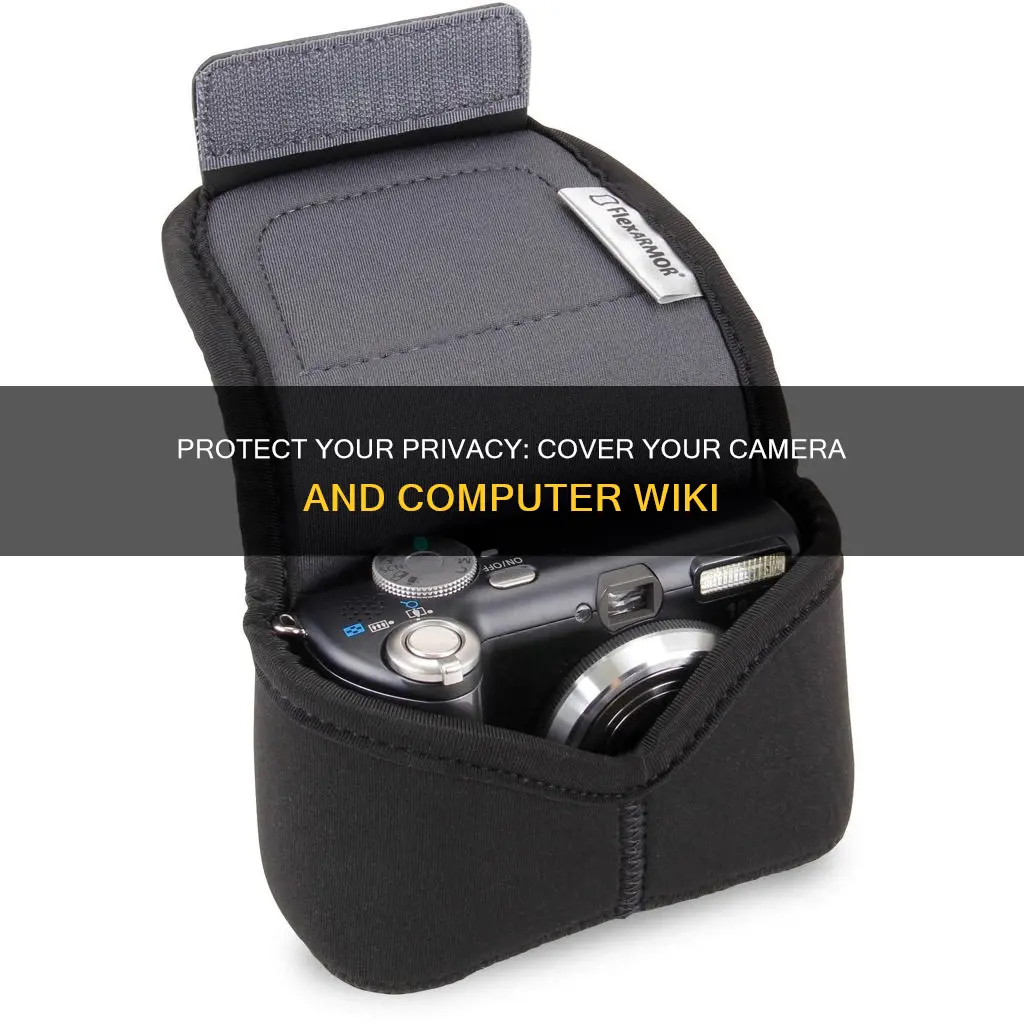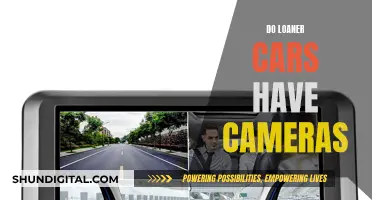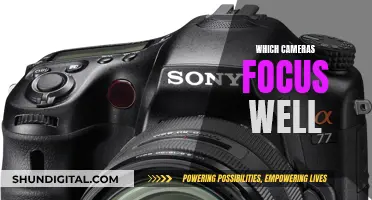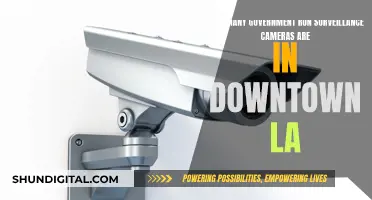
Covering your computer camera is a quick and easy way to protect your privacy. Although it may seem paranoid, there are potential risks to leaving your computer camera exposed, such as malware attacks or accidental sharing of your surroundings during online meetings. Thankfully, there are several simple and inexpensive ways to cover your webcam and take control of your privacy. From using tape or stickers to installing a sliding webcam cover, you can easily find a solution that fits your needs and style. In today's digital age, taking steps to protect your privacy is crucial, and covering your computer camera is an important part of that.
| Characteristics | Values |
|---|---|
| Reasons to cover your camera | To prevent potential malware attacks and accidental sharing of your surroundings during video calls |
| Types of cover | Tape, stickers, post-its, cloth, tissue paper, cardboard, commercially available webcam covers |
| Tape options | Invisible tape, duct tape, painter's tape, washi tape |
| Sticker options | Cute designs, custom designs, company logos, pet pictures |
| Commercially available webcam cover features | Slim, user-friendly, convenient, practical, lightweight, customizable |
What You'll Learn

Tape
How to Cover Your Computer Camera with Tape
Covering your computer camera with tape is a quick and easy way to protect your privacy. While there are other methods to achieve this, using tape is a simple solution that doesn't require purchasing additional equipment.
Invisible Tape
Using invisible tape is a quick way to obscure your surroundings from view. This method is ideal if you don't want to draw attention to the fact that you're covering your camera. However, it may not be as effective at blocking light as other options.
Washi Tape
Washi tape is a decorative tape that adds a stylish touch to your computer. It's easy to remove, making it a good choice if you need to access your camera occasionally.
Painter's Tape
Painter's tape is a good alternative to duct tape, as it provides a sturdy barrier without leaving behind a lot of residue. Duct tape, while effective at blocking the camera, can be difficult to remove and may damage your camera lens.
Considerations
While taping over your camera lens can provide privacy, it's important to consider potential drawbacks. Tape residue can build up and damage your camera or laptop screen. Additionally, covering the camera may interfere with the environmental brightness sensor, affecting features like automatic brightness adjustment.
For a more sophisticated solution, consider purchasing a laptop with built-in privacy features, such as the AERO and GIGABYTE G series laptops, which offer a sliding lens cap and fingerprint identification technology.
Off-Brand Camera Batteries: Overheating Risk?
You may want to see also

Post-it notes
Covering Your Camera with Post-it Notes
Using Post-it notes to cover your camera is a quick, simple, and effective solution. Post-its are paper-thin, so they won't damage your device, and they're wide enough to ensure your camera is fully covered. They're also easy to replace, as most people tend to have a stack of Post-its lying around.
However, the adhesive on Post-its may not be strong enough to keep them in place for long, and they could come off during ordinary use of your device. They may also leave a sticky residue on the lens, which can be a problem if you want to use your camera later.
The colour of the Post-it note is another factor to consider. Lighter shades, like the common yellow variety, may let enough light through to capture an image. Darker shades are more effective at blocking the camera's view.
If you're looking for a quick, no-fuss solution to cover your camera, Post-it notes are a good option. Just be aware of the potential issues with adhesion and light filtration, and choose a darker shade if possible.
Understanding ZSL Camera Mode: How It Works and Benefits
You may want to see also

Stickers
Alternatively, you can use any small sticker that is big enough to cover the lens. For example, you could use a fun sticker with a design such as a flower, logo, symbol, or smiley face. You can find small stickers like these in craft stores or children's sticker books.
When choosing a sticker to cover your camera, consider the following:
- Appearance: Choose a sticker that you like the look of and that fits the aesthetic of your device.
- Size: Make sure the sticker is big enough to completely cover the lens. The front camera on most phones is usually around 0.25 inches (0.64 cm) in diameter, while the back camera is larger, typically around 0.5-1 inch (1.3-2.5 cm) in diameter.
- Ease of removal: If you think you may want to remove the sticker at some point, choose one that is designed to be easily removable and reusable, such as the adhesive-free CamTag stickers.
- Adhesion: Look for a sticker with strong adhesion that will stay put on your device. However, be aware that very strong adhesives may leave residue behind when removed.
In addition to stickers, there are other ways to cover your computer camera, including electrical tape, adhesive camera covers, slide covers, and built-in camera cover sliders on phone cases. However, stickers are a convenient and effective option that can give your device a little personality while also protecting your privacy.
Understanding Long Shutter Mode in Photography
You may want to see also

Cloth
Using a cloth to cover your webcam is a simple and effective way to protect your privacy. It is a good option if you are in a hurry or need a temporary solution. Any piece of cloth can be used, but it is important to ensure that the cloth is thick enough to block the camera image. For example, a handkerchief may not be the best choice as it is made of thin, see-through material. A better option would be a dish cloth or a hand towel, as these are thicker and will provide more privacy.
To use a cloth as a webcam cover, simply place it over the camera. You can use paper or binder clips to hold it in place. This method will provide good privacy, but it may not be the most aesthetically pleasing option. It is also important to note that a cloth may not cover the IR lights that surround the camera lens, so if you are using night vision features, this could be a concern. Additionally, people may ask about the cloth covering your camera, so it may not be the most discreet option.
While using a cloth to cover your webcam is a quick and easy solution, there are also other methods you can consider, such as tape, stickers, or purchasing a webcam cover. These options may offer more discretion and could be more suitable if you plan on using your computer in public. However, some types of tape and stickers can leave a sticky residue on your camera, so it is important to choose an option that will not damage your device.
Charging Your SP815UZ: Battery Power Basics
You may want to see also

Tissue paper
If you want to get creative, you can even make an origami webcam cover out of tissue paper. Here's a simple tutorial:
- Measure the height of your laptop bezel, usually between 1-2 cm.
- Cut a piece of tissue paper where the length is 8 times the bezel height and the width is 4 times the bezel height. For example, if your bezel height is 1.5 cm, the tissue paper measurement should be 12 cm by 6 cm.
- Fold the tissue paper in half.
- Make diagonals and a heart shape in one half.
- Fold the other half behind the heart.
- Tuck in the sides and make some creases, and you're done!
Another option is to print on tissue paper and then use it as a webcam cover. Here's what you'll need:
- Tape
- Iron
- Standard computer paper (8 1/2" x 11" or 8 1/2" x 14")
- Tissue paper (cut to 8" x 10")
- Computer and printer
- Create your design on the computer and place it where you want it on the tissue paper.
- Cut the tissue paper to the desired size and lightly iron it to remove wrinkles.
- Tape the tissue paper to the standard computer paper, smoothing out any bubbles, and securing all 4 corners.
- Load your printer according to its type and print. Stay by your printer in case you need to guide the paper.
Now you have a customised tissue paper webcam cover!
The Ultimate Guide to Installing Camera Mods
You may want to see also
Frequently asked questions
Covering your computer camera can protect your privacy and give you peace of mind. While stories of malicious internet villains hacking into webcams are often exaggerated, there are potential risks to leaving your camera exposed, such as malware attacks. Additionally, if you work remotely or frequently participate in video calls, covering your camera can prevent accidentally showing your surroundings.
There are several simple methods to cover your computer camera:
- Use invisible tape for a discreet barrier.
- Place a cute sticker over the camera for a fun and protective layer.
- Apply duct tape for a sturdy and inexpensive solution, but be aware that it may leave residue.
- Install a sliding webcam cover that can be easily adjusted to cover or uncover the lens.
Yes, in addition to physical covers, there are other ways to enhance your privacy:
- Use privacy shields that force your device to point in a single direction, making it difficult for snoops to see your surroundings.
- Install anti-virus software and keep your devices updated to protect against hacks.
- Regularly check and revoke camera access permissions for any suspicious or unnecessary apps.







